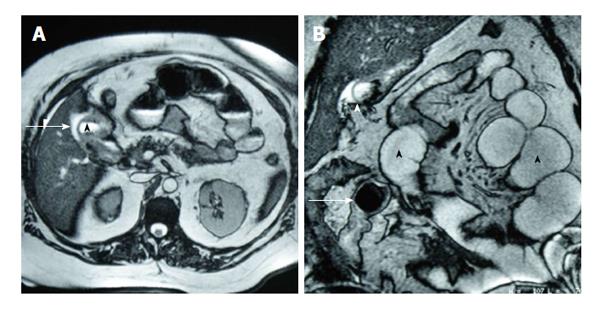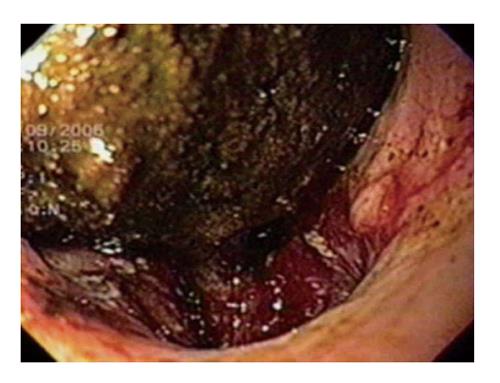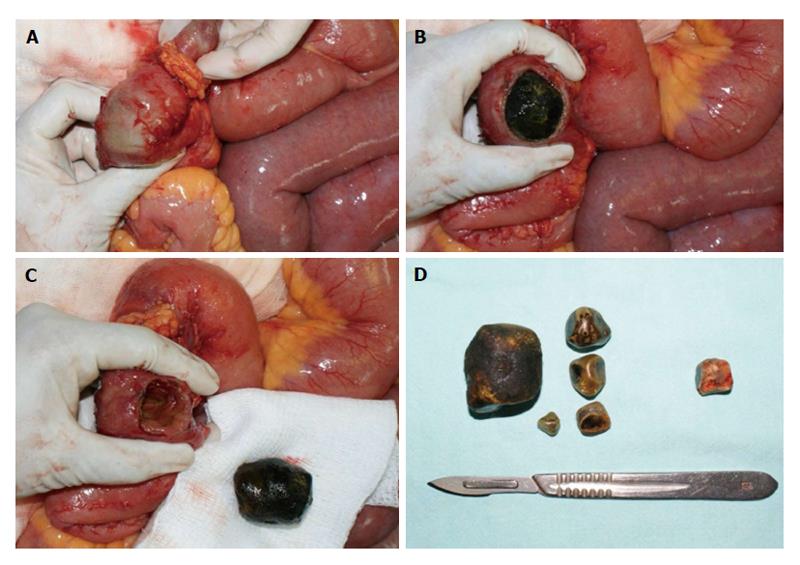Copyright
©The Author(s) 2016.
World J Gastrointest Surg. Jan 27, 2016; 8(1): 65-76
Published online Jan 27, 2016. doi: 10.4240/wjgs.v8.i1.65
Published online Jan 27, 2016. doi: 10.4240/wjgs.v8.i1.65
Figure 1 Plain abdominal radiograph showing dilated small bowel loops and a high density endoluminal image suggestive of a gallstone (arrow).
No pneumobilia is visualized.
Figure 2 Ultrasound findings in a patient with gallstone ileus.
A: Hyperechoic images without acoustic shadow in a non-dilated common bile duct, suggestive of air in the bile duct (arrow). Right portal vein was identified by Doppler US; B: US showing hyperechoic images without acoustic shadow in a collapsed gallbladder (arrow) and duodenum, suggestive of endoluminal air (short arrow). Liver parenchyma (arrowhead); C: Fluid-filled dilated proximal jejunum bowel loop (arrowhead). US: Ultrasound.
Figure 3 Contrast-enhanced computed tomography findings in a patient with gallstone ileus.
A: Portal phase IV-contrast enhanced computed tomography section reveals air in the hepatic duct (arrow), anterior to a permeable right portal vein (arrowhead); B: Communication between a non-distended gallbladder (arrowhead) and the duodenum (arrow), where presence of air is observed. Fluid-filled dilated jejunum loops and intestinal pneumatosis are seen (short arrow); C: Endoluminal round-shaped calcium-density images (arrows), and dilated small bowel loops (arrowhead) with pneumatosis (short arrow).
Figure 4 Magnetic resonance cholangiopancreatography findings in a patient with gallstone ileus.
A: On T2-MRI, a hyperintense image is identified in the gallbladder bed (arrow), with communication with the duodenal second portion (arrowhead), suggestive of a cholecystoduodenal fistula; B: MRI coronal reconstruction showed dilated small bowel loops with endoluminal air (black arrowheads) and a signal-void round-shaped image, suggestive of a gallstone (arrow). Gallbladder communication with duodenum is observed (white arrowhead). MRI: Magnetic resonance imaging.
Figure 5 Esophagogastroduodenoscopy in a patient with Bouveret’s syndrome revealed a gallstone in the duodenal bulb and the fistulous sinus.
Courtesy of Gabriela Quintero-Tejeda, MD, Department of Gastrointestinal Endoscopy, Unidad Médica de Alta Especialidad, Hospital de Especialidades del Centro Médico Nacional de Occidente, Instituto Mexicano del Seguro Social.
Figure 6 Surgical findings in a patient with gallstone ileus.
A: An impacted gallstone was found in distal jejunum. A smaller gallstone proximal to the impacted one is observed; B: Enterotomy over the site of the impacted gallstone; C: Intestinal wall compromise due to gallstone impaction can be observed; D: The offending gallstone, plus four of smaller dimensions found in proximal jejunum. An obstructing gallstone was found and extracted from the common bile duct in the same patient (gallstone on the right).
- Citation: Nuño-Guzmán CM, Marín-Contreras ME, Figueroa-Sánchez M, Corona JL. Gallstone ileus, clinical presentation, diagnostic and treatment approach. World J Gastrointest Surg 2016; 8(1): 65-76
- URL: https://www.wjgnet.com/1948-9366/full/v8/i1/65.htm
- DOI: https://dx.doi.org/10.4240/wjgs.v8.i1.65














